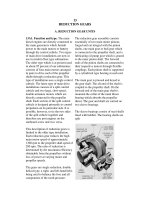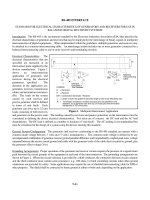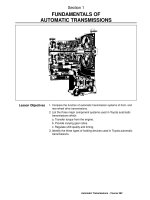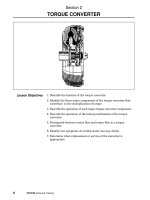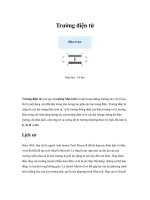Tài liệu Engineering Tribology P2 pptx
Bạn đang xem bản rút gọn của tài liệu. Xem và tải ngay bản đầy đủ của tài liệu tại đây (607.19 KB, 10 trang )
P
HYSICAL
P
ROPERTIES OF
L
UBRICANTS
15
log
10
(υ + a) = log
10
b + 1/T
c
(2.6)
It has also been found that if ‘υ’ is in [cS] then ‘a’ is approximately equal to 0.6. After
substituting this into the equation, the logs were taken again in the manner shown below:
log
10
log
10
(υ
cS
+ 0.6) = a' − clog
10
T (2.7)
where:
a', c are constants.
Although equation (2.7) forms successful bases for the ASTM viscosity-temperature chart,
where the ordinate is log
10
log
10
(υ
cS
+ 0.6) and the abscissa is log
10
T, from the mathematical
view point the above derivation is incorrect. This is because when taking logs, equation (2.6)
should be in the form:
log
10
log
10
(υ
cS
+ 0.6) = log
10
(log
10
b + 1/T
c
)
consequently,
a' − clog
10
T ≠ log
10
(log
10
b + 1/T
c
)
Despite this the ASTM chart is quite successful and works very well for mineral and
synthetic oils under normal conditions. It is so well standardized that the viscosity-
temperature characteristics are sometimes specified as ‘ASTM slope’.
2.4 VISCOSITY INDEX
Different oils may have different ASTM slopes as shown in Figure 2.2. As early as 1920 it was
known that Pennsylvania crude oils were better than the Gulf Coast (Texan) crude oils.
Pennsylvania crude had the best viscosity temperature characteristics while the Gulf Coast
crude had the worst since its viscosity varied much more with temperature. From the
engineering viewpoint there was a need for a parameter which would accurately describe the
viscosity-temperature characteristics of the oils. In 1929 a ‘Viscosity Index’ was developed by
Dean and Davis [1,2]. The viscosity index is an entirely empirical parameter which compares
the kinematic viscosity of the oil of interest to the viscosities of two reference oils which
have a considerable difference in sensitivity of viscosity to temperature. The reference oils
have been selected in such a way that one of them has the viscosity index equal to zero (VI=0)
and the other has the viscosity index equal to one hundred (VI=100) at 100°F (37.8°C) but they
both have the same viscosity as the oil of interest at 210°F (98.89°C), as illustrated in Figure
2.3.
Since Pennsylvania and Gulf Coast oils have the same viscosity at 210°F (98.9°C) they were
initially selected as reference oils. Oils made from Pennsylvania crude were assigned the
viscosity index of 100 whereas oils made from the Gulf Coast crude the viscosity index of 0.
The viscosity index can be calculated from the following formula:
VI = (L − U) / (L − H)
×
100 (2.8)
Firstly the kinematic viscosity of the oil of interest is measured at 40°C (‘U’) and at 100°C.
Then from Table 2.2 [3] (ASTM D2270), looking at the viscosity at 100°C of the oil of interest,
the corresponding values of the reference oils, ‘L’ and ‘H’ are read. Substituting the obtained
values of ‘U’, ‘L’ and ‘H’ into the above equation yields the viscosity index.
Note that the viscosity index is an inverse measure of the decline in oil viscosity with
temperature. High values indicate that the oil shows less relative decline in viscosity with
TEAM LRN
16 E
NGINEERING
T
RIBOLOGY
temperature. The viscosity index of most of the refined mineral oils available on the market
is about 100, whereas multigrade and synthetic oils have higher viscosity indices of about 150.
Mineral Oil
20 VI
Mineral Oil
100 VI
Mineral Oil
150 VI
-40 -20 0 20 40 60
80
100 120 140 160
Di-ester
140 VI
Chlorinated
Silicone
185 VI
100 000
10 000
5 000
1 000
500
200
100
50
20
10
8.0
6.0
4.0
3.0
2.0
1.5
Temperature [°C]
Kinematic Viscosity [cS]
Silicone
240 VI
SAE 30W
100 VI
Mineral Oil
160 VI
°
F
IGURE
2.2 Viscosity-temperature characteristics of selected oils (adapted from [29 and 22]).
EXAMPLE
Find the viscosity index of an oil which has a kinematic viscosity at 40°C of
υ
40
= 135 [cS] and at 100°C of υ
100
= 17 [cS]. From Table 2.2 for υ
100
= 17 [cS], L = 369.4
and H = 180.2 can be found. Substituting into the viscosity index equation yields:
VI = (369.4 − 135) / (369.4 − 180.2)
×
100 = 123.9
2.5 VISCOSITY PRESSURE RELATIONSHIP
Lubricant viscosity increases with pressure. For most lubricants this effect is considerably
larger than the effect of temperature or shear when the pressure is significantly above
atmospheric. This is of particular importance in the lubrication of heavily loaded
concentrated contacts which can be found, for example, in rolling contact bearings and gears.
The pressures encountered in these contacts can be so high and the rate of pressure rise so
rapid that the lubricant behaves like a solid rather than a liquid. The phenomenon of
viscosity increasing with pressure and the possibility of lubricant failure by fracture rather
than viscous shear is often observed but not always recognized. For example, when asphalt
or pitch is hit with a hammer it will shatter, on the other hand when placed on an incline it
will slowly flow.
TEAM LRN
P
HYSICAL
P
ROPERTIES OF
L
UBRICANTS
17
Kinematic Viscosity [cS]
υ
L
υ
U
υ
H
L
U
H
100 VI
0 VI
37.8 98.9
Temperature [°C]°
F
IGURE
2.3 Evaluation of viscosity index [23].
A number of attempts have been made to develop a formula describing the relationship
between pressure and viscosity of lubricants. Some have been quite satisfactory, especially at
low pressures, while others have been quite complex and not easily applicable in practice.
The best known equation to calculate the viscosity of a lubricant at moderate pressures (close
to atmospheric) is the Barus equation [4,5]. The application of this equation to pressures
above 0.5 [GPa] can, however, lead to serious errors [6]. The equation becomes even more
unreliable if the ambient temperature is high. The Barus equation is of the form:
η
p
= η
0
e
αp
(2.9)
where:
η
p
is the viscosity at pressure ‘p’ [Pas];
η
0
is the atmospheric viscosity [Pas];
α is the pressure-viscosity coefficient [m
2
/N], which can be obtained by plotting the
natural logarithm of dynamic viscosity ‘η’ versus pressure ‘p’. The slope of the
graph is ‘α’;
p is the pressure of concern [Pa].
For higher pressures Chu et al. [7] suggested that the following formula can be used:
η
p
= η
0
(1 + C
×
p)
n
(2.10)
where:
C, n are constants, ‘n’ is approximately 16 for most cases and ‘C’ can be obtained from
the diagram shown in Figure 2.4 [7,8].
The pressure-viscosity coefficient is a function of the molecular structure of the lubricant and
its physical characteristics such as molecular interlocking, molecular packing and rigidity and
viscosity-temperature characteristics.
There are various formulae available to calculate the pressure-viscosity coefficient. One of
the early ones was derived by Wooster [5]:
α = (0.6 + 0.965log
10
η
0
)
×
10
−8
(2.11)
where:
α is the pressure-viscosity coefficient [m
2
/N];
TEAM LRN
18 E
NGINEERING
T
RIBOLOGY
η
0
is the atmospheric viscosity [cP], i.e. 1[cP] = 10
-3
[Pas].
T
ABLE
2.2 Data for the evaluation of viscosity index [3].
2.00
2.10
2.20
2.30
2.40
2.50
2.60
2.70
2.80
2.90
3.00
3.10
3.20
3.30
3.40
3.50
3.60
3.70
3.80
3.90
4.00
4.10
4.20
4.30
4.40
4.50
4.60
4.70
4.80
4.90
5.00
5.10
5.20
5.30
5.40
5.50
5.60
5.70
5.80
5.90
6.00
6.10
6.20
6.30
6.40
6.50
6.60
6.70
6.80
6.90
7.00
7.10
7.20
7.30
7.40
7.50
7.60
7.70
7.80
7.90
8.00
8.10
8.20
7.994
8.640
9.309
10.00
10.71
11.45
12.21
13.00
13.80
14.63
15.49
16.36
17.26
18.18
19.12
20.09
21.08
22.09
23.13
24.19
25.32
26.50
27.75
29.07
30.48
31.96
33.52
35.13
36.79
38.50
40.23
41.99
43.76
45.53
47.31
49.09
50.87
52.64
54.42
56.20
57.97
59.74
61.52
63.32
65.18
67.12
69.16
71.29
73.48
75.72
78.00
80.25
82.39
84.53
86.66
88.85
91.04
93.20
95.43
97.72
100.0
102.3
104.6
6.394
6.894
7.410
7.944
8.496
9.063
9.647
10.25
10.87
11.50
12.15
12.82
13.51
14.21
14.93
15.66
16.42
17.19
17.97
18.77
19.56
20.37
21.21
22.05
22.92
23.81
24.71
25.63
26.57
27.53
28.49
29.46
30.43
31.40
32.37
33.34
34.32
35.29
36.26
37.23
38.19
39.17
40.15
41.13
42.14
43.18
44.24
45.33
46.44
47.51
48.57
49.61
50.69
51.78
52.88
53.98
55.09
56.20
57.31
58.45
59.60
60.74
61.89
8.30
8.40
8.50
8.60
8.70
8.80
8.90
9.00
9.10
9.20
9.30
9.40
9.50
9.60
9.70
9.80
9.90
10.0
10.1
10.2
10.3
10.4
10.5
10.6
10.7
10.8
10.9
11.0
11.1
11.2
11.3
11.4
11.5
11.6
11.7
11.8
11.9
12.0
12.1
12.2
12.3
12.4
12.5
12.6
12.7
12.8
12.9
13.0
13.1
13.2
13.3
13.4
13.5
13.6
13.7
13.8
13.9
14.0
14.1
14.2
14.3
14.4
14.5
106.9
109.2
111.5
113.9
116.2
118.5
120.9
123.3
125.7
128.0
130.4
132.8
135.3
137.7
140.1
142.7
145.2
147.7
150.3
152.9
155.4
158.0
160.6
163.2
165.8
168.5
171.2
173.9
176.6
179.4
182.1
184.9
187.6
190.4
193.3
196.2
199.0
201.9
204.8
207.8
210.7
213.6
216.6
219.6
222.6
225.7
228.8
231.9
235.0
238.1
241.2
244.3
247.4
250.6
253.8
257.0
260.1
263.3
266.6
269.8
273.0
276.3
279.6
63.05
64.18
65.32
66.48
67.64
68.79
69.94
71.10
72.27
73.42
74.57
75.73
76.91
78.08
79.27
80.46
81.67
82.87
84.08
85.30
86.51
87.72
88.95
90.19
91.40
92.65
93.92
95.19
96.45
97.71
98.97
100.2
101.5
102.8
104.1
105.4
106.7
108.0
109.4
110.7
112.0
113.3
114.7
116.0
117.4
118.7
120.1
121.5
122.9
124.2
125.6
127.0
128.4
129.8
131.2
132.6
134.0
135.4
136.8
138.2
139.6
141.0
142.4
14.6
14.7
14.8
14.9
15.0
15.1
15.2
15.3
15.4
15.5
15.6
15.7
15.8
15.9
16.0
16.1
16.2
16.3
16.4
16.5
16.6
16.7
16.8
16.9
17.0
17.1
17.2
17.3
17.4
17.5
17.6
17.7
17.8
17.9
18.0
18.1
18.2
18.3
18.4
18.5
18.6
18.7
18.8
18.9
19.0
19.1
19.2
19.3
19.4
19.5
19.6
19.7
19.8
19.9
20.0
20.2
20.4
20.6
20.8
21.0
21.2
21.4
21.6
283.0
286.4
289.7
293.0
296.5
300.0
303.4
306.9
310.3
313.9
317.5
321.1
324.6
328.3
331.9
335.5
339.2
342.9
346.6
350.3
354.1
358.0
361.7
365.6
369.4
373.3
377.1
381.0
384.9
388.9
392.7
396.7
400.7
404.6
408.6
412.6
416.7
420.7
424.9
429.0
433.2
437.3
441.5
445.7
449.9
454.2
458.4
462.7
467.0
471.3
475.7
479.7
483.9
488.6
493.2
501.5
510.8
519.9
528.8
538.4
547.5
556.7
566.4
143.9
145.3
146.8
148.2
149.7
151.2
152.6
154.1
155.6
157.0
158.6
160.1
161.6
163.1
164.6
166.1
167.7
169.2
170.7
172.3
173.8
175.4
177.0
178.6
180.2
181.7
183.3
184.9
186.5
188.1
189.7
191.3
192.9
194.6
196.2
197.8
199.4
201.0
202.6
204.3
205.9
207.6
209.3
211.0
212.7
214.4
216.1
217.7
219.4
221.1
222.8
224.5
226.2
227.7
229.5
233.0
236.4
240.1
243.5
247.1
250.7
254.2
257.8
21.8
22.0
22.2
22.4
22.6
22.8
23.0
23.2
23.4
23.6
23.8
24.0
24.2
24.4
24.6
24.8
25.0
25.2
25.4
25.6
25.8
26.0
26.2
26.4
26.6
26.8
27.0
27.2
27.4
27.6
27.8
28.0
28.2
28.4
28.6
28.8
23.0
29.2
29.4
29.6
29.8
30.0
30.5
31.0
31.5
32.0
32.5
33.0
33.5
34.0
34.5
35.0
35.5
36.0
36.5
37.0
37.5
38.0
38.5
39.0
39.5
40.0
40.5
575.6
585.2
595.0
604.3
614.2
624.1
633.6
643.4
653.8
663.3
673.7
683.9
694.5
704.2
714.9
725.7
736.5
747.2
758.2
769.3
779.7
790.4
801.6
812.8
824.1
835.5
847.0
857.5
869.0
880.6
892.3
904.1
915.8
927.6
938.6
951.2
963.4
975.4
987.1
998.9
1011
1023
1055
1086
1119
1151
1184
1217
1251
1286
1321
1356
1391
1427
1464
1501
1538
1575
1613
1651
1691
1730
1770
261.5
264.9
268.6
272.3
275.8
279.6
283.3
286.8
290.5
294.4
297.9
301.8
305.6
309.4
313.0
317.0
320.9
324.9
328.8
332.7
336.7
340.5
344.4
348.4
352.3
356.4
360.5
364.6
368.3
372.3
376.4
380.6
384.6
388.8
393.0
396.6
401.1
405.3
409.5
413.5
417.6
421.7
432.4
443.2
454.0
464.9
475.9
487.0
498.1
509.6
521.1
532.5
544.0
555.6
567.1
579.3
591.3
603.1
615.0
627.1
639.2
651.8
664.2
41.0
41.5
42.0
42.5
43.0
43.5
44.0
44.5
45.0
45.5
46.0
46.5
47.0
47.5
48.0
48.5
49.0
49.5
50.0
50.5
51.0
51.5
52.0
52.5
53.0
53.5
54.0
54.5
55.0
55.5
56.0
56.5
57.0
57.5
58.0
58.5
59.0
59.5
60.0
60.5
61.0
61.5
62.0
62.5
63.0
63.5
64.0
64.5
65.0
65.5
66.0
66.5
67.0
67.5
68.0
68.5
69.0
69.5
70.0
1810
1851
1892
1935
1978
2021
2064
2108
2152
2197
2243
2288
2333
2380
2426
2473
2521
2570
2618
2667
2717
2767
2817
2867
2918
2969
3020
3073
3126
3180
3233
3286
3340
3396
3452
3507
3563
3619
3676
3734
3792
3850
3908
3966
4026
4087
4147
4207
4268
4329
4392
4455
4517
4580
4645
4709
4773
4839
4905
676.6
689.1
701.9
714.9
728.2
741.3
754.4
767.6
780.9
794.5
808.2
821.9
835.5
849.2
863.0
876.9
890.9
905.3
919.6
933.6
948.2
962.9
977.5
992.1
1007
1021
1036
1051
1066
1082
1097
1112
1127
1143
1159
1175
1190
1206
1222
1238
1254
1270
1286
1303
1319
1336
1352
1369
1386
1402
1419
1436
1454
1471
1488
1506
1523
1541
1558
υ
100
LH
υ
100
LH
υ
100
LH
υ
100
LH
υ
100
LH
υ
100
is the kinematic viscosity of the oil of interest at 100°C in [cS].
Although this exponential law fits most lubricants it is not particularly accurate. There are
also other equations for the calculation of the pressure-viscosity coefficient available in the
literature. It is often reported that some of these equations are accurate for certain fluids but
TEAM LRN
P
HYSICAL
P
ROPERTIES OF
L
UBRICANTS
19
unsuitable for others. One of the best formulae for the analytical determination of the
pressure-viscosity coefficient is the empirical expression developed by So and Klaus [9]. A
combination of linear and nonlinear regression analyses with atmospheric viscosity, density
and the viscosity temperature property (modified ASTM slope) was applied to obtain the
following expression:
α =
1.216+4.143
×
(log
10
υ
0
)
3.0627
+2.848
×
10
−4
×
b
5.1903
(log
10
υ
0
)
1
.5976
−3.999
×
(log
10
υ
0
)
3.0975
ρ
0.1162
(2.12)
where:
α is the pressure-viscosity coefficient [
×
10
-8
m
2
/N];
υ
0
is the kinematic viscosity at the temperature of interest [cS];
b is the ASTM slope of a lubricant divided by 0.2;
ρ is the atmospheric density at the temperature of interest in [g/cm
3
].
1000
500
200
100
50
20
10
5
2
1
[ 10 Pa ]
×
-9 -1
C
0123
Viscosity [cP]
η
0
0.001
0.002
0.005
0.01
0.02
0.05
0.1
0.2
0.5
1
10243852
65
79
93
107
121
149
177
204
Viscosity [Pas]
η
0
Oil temperature [
o
C]
F
IGURE
2.4 Graph for the determination of the constant ‘C’ (adapted from [8]).
One of the problems associated with available formulae is that they only allow the accurate
calculation of pressure-viscosity coefficients at low shear rates. In many engineering
applications, especially in the heavily loaded concentrated contacts however, the lubricant
operates under very high shear rates and the precise values of the pressure-viscosity
coefficient are needed for the evaluation of the minimum film thickness. An accurate value
of this coefficient can be determined experimentally and this problem is discussed later.
If an accurate analytical formula could be developed it would certainly be useful. It could
provide a relationship between the fundamental parameters of the lubricant and the
pressure-viscosity coefficient as opposed to being a strictly empirical equation. This would
open up the possibilities of modifying the chemical make up of the lubricant in order to
achieve the desired pressure-viscosity coefficient for specific applications. A limited attempt
to find such a relationship was reported by Johnston [15].
TEAM LRN





